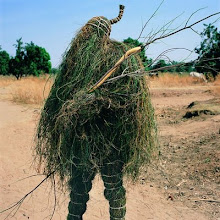bees hard at work on the figure of the martyred christ
image courtesy of carpenters workshop gallery
I am not a huge fan of conceptual art. However, this piece fascinated me, not in its concept...blah blah blah religion and its endlessly toiling followers...blah blah blah, but in the mechanics of its construction. Somehow the artist got these bees to build their comb on a human shaped armature, fill it with honey and then empty the honey back out into their own hive. I would like to see some images of the piece in process. Was it made in the gallery? If so, how the heck did he make it so the bees could forage for the materials to build comb over the human form in the vitrine? Does the artist have beekeeping experience? So many questions.
From DesignBoom
June 22, 2010
tomas gabzdil libertiny: unbearable lightness
'unbearable lightness'
125 x 125 x 48 cm
in an edition of 6 + 2AP"
During design miami / basel 2010, carpenters workshop gallery (london) presented 'unbearable lightness' by dutch designer tomáš gabzdil libertiny. suspended on four chains and a hook, the small cabinet is a clean-room unit that has been built from custom aluminium profiles, glass sheets and plastic inserts, elements which are typically used in the automation industry.
For this specific event, the base plate of the glass was cut with a queen restrictor mesh. Over the course of the fair, 40 000 worker bees were released into the case to complete a wax honeycomb structure over the figure of a martyred christ rising out of the chaos, his weight seeming to be upheld by the mass strength of the swarm. the artist managed to gain complete control over the bees and lure them to construct their hive precisely over the figure within the vitrine that is made of a laser sintered framework. the industrious bees created a honeycomb skin over the figure before filling each cell with the honey they produce. then bees worked to remove the honey from the cells and return it to the beehive, cleaning the martyred christ back to the wax cells they originally created.
image courtesy of carpenters workshop gallery
bees hard at work
image courtesy of carpenters workshop gallery
Libertiny's allegory engages us with his desire to manipulate and control a social wild-life entity as the means to fulfilling the final product. here the bees,
engaging in their repetitive natural process while unknowingly creating the world's most recognized religious effigy. the suspended closed cabinet references the strict boundaries of society where the toil of everyday duty is masked by the hope of eternal rest in an after-life promised by the believer. the bees are programmed to act for their queen who puppet-rules for libertiny. the viewer is able to recognize this element of manipulation of the bees while ignorant to the invisible constraints and measures imposed on our own existence. initially, tomáš introduced a natural red pigment into the mold which bees spread evenly across the whole figure. the red relates to blood and flesh and is also the only color in the visible spectrum that bees do not see."
the honeycomb skin the bees created
image courtesy of carpenters workshop gallery
designer tomáš gabzdil libertiny
image courtesy of design miami / basel
image courtesy of carpenters workshop gallery

No comments:
Post a Comment